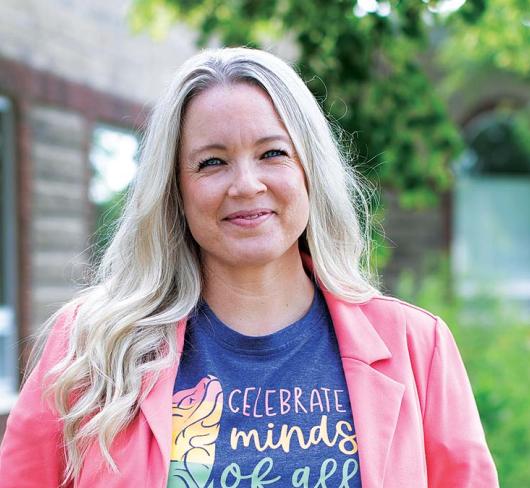
Dismantling the Gender Binary and Sexism in Our Schools
It’s been a long time since we separated boys from girls in the school yard, but my mother can remember the two distinct sides of the playground at her childhood school: one for boys, one for girls. You can still read the labels carved into the masonry above the doors of the separate boys’ and girls’ entrances of many old schools. Any educator today would likely agree that that division was misguided and harmful. Yet, these divisions linger. They permeate our culture and our classrooms. These divisions are absolutely detrimental to the well-being of transgender and gender-expansive students; however, gender divisions are damaging to everyone.
I hated elementary school. I was a trans, non-binary kid, although I didn’t know that at the time. I fit in nowhere and suffered bullying and ostracization. I was assigned female at birth and didn’t have any major body dysmorphia, but I definitely knew that girl was not my gender. Although I felt mostly like a boy, I had no desire to be limited to the male gender norms either. I was constantly misgendered, which, even before I knew why, always hurt. Being seen and treated as a girl felt as if I was constantly being ridiculed, like being forced to wear a costume that was uncomfortable and humiliating, but I didn’t have the language to explain my gender.
While I certainly had other privileges, the repetitive trauma of living as a non-binary person in a cis-heteronormative world had long-term effects, such as anxiety and low self-esteem, and denial of my true self until adulthood. These symptoms are not uncommon for queer folks. What’s worse is that we are made to feel as if we are the ones with the problem. If a cis guy is called a girl, they are expected to react with anger, and we sympathize with them as we recognize that being called an incorrect gender lands as insulting and is often the basis of bullying. But when a trans person gets misgendered, we are being “too sensitive” if we feel anything at all, or even notice. “Why do you care?” I am asked. Perhaps it is because being seen as the incorrect gender comes with different rules, assumptions and expectations.
Perhaps if every person who made the incorrect guess that I identified as a girl treated me the same as they would any boy, it wouldn’t matter as much. But that isn’t the case. Our society still treats men and women, boys and girls, very differently. You really notice that when you don’t fit into the gender binary. You notice every time gender is policed or folks make statements alluding to the false “inherent differences” in gender behaviour, which is daily. Every. Single. Time.
As an educator, I have dedicated my career to making school a safer place for queer and trans kids, and for everyone to feel a sense of belonging and be valued for who they are. I serve as equity lead within my school, I run GSAs (Gender-Sexuality Alliances) for students and assist with professional development to help educators support 2SLGBTQIA+ students and integrate inclusive education into their practice. I do my best to be a safe adult for students and model respectful behaviour. I also do my best to be a safe colleague for other educators to ask questions and to learn alongside me. Through this work I have noticed that the root cause of discrimination against the queer community is simply sexism and gender policing, and that schools are still fraught with issues. If we believed that there is no gender hierarchy, that all genders are equal, and gender does not limit you, then nobody would care who you fall in love with, what clothes you wear, or which washroom you use. If we are to end the oppression of the 2SLGBTQIA+ community, we need to end sexism and the gender binary.
It is possible that this article may challenge your thinking. I am asking you to take on that challenge. Recognize that if you have long-held beliefs that a person’s biological sex determines their behaviours, you may have also put energy into gender policing yourself throughout your life, likely unconsciously. If this is the case, you may experience an emotional reaction to the process of unlearning. That is normal and you can consider it part of letting go. It is possible that you may also experience grieving, as your life has likely been impacted by trying to meet gender expectations. You may also experience guilt if you have participated in the gender policing of others. Please know that you are not at fault. It is what we were taught. These beliefs are so deeply ingrained within our culture, language, systems, media and structures, we couldn’t help but internalize it. Now is the time to unlearn. We can dismantle, we can rebuild, and we can do better.
The good news is that we have already progressed so much. Alright, I know – we still have a long way to go to reach equality. Rates of partner violence against women remain appallingly high. Women have poorer financial outcomes and higher burdens of unpaid work, and deep cultures of misogyny persist within so many of our institutions. But it really wasn’t that long ago that it was believed that women couldn’t run marathons or were not permitted to vote or have bank accounts. Only a generation ago, women could only have certain credit cards with the permission of their husbands. Now these notions would be considered absurd by nearly everyone. Sexual orientation and gender identity are now protected against discrimination by law, but it was only in 1971 that the last person was released from imprisonment for the crime of homosexual acts in Canada. I state these examples because they demonstrate that change is possible, and it is happening around us all the time. There is much work to be done, but we can get there. We need to keep believing we can achieve equality and to keep working towards it.
So, let’s get on with dismantling the gender binary, shall we?
But what is gender? We know gender is a social construct, and that nearly all human behaviour is learned. This means that gender norms – that is, expected interests, values, behaviours, roles and presentation (clothes and appearance) – are created by society. They change over time and they differ between societies.
Gender is not the same as biological sex, which can be female, male or various forms of intersex. One’s gender may match their sex or the gender they were assigned at birth (cisgender), or it may not (transgender). Some people deny these facts or try to hide them from children due to transphobia, but intersex people and trans people are real. They exist now and they have always existed. When I teach children about gender identity, I compare gender to someone’s name. When you first meet someone and you don’t know what their name is yet, it isn’t wise to simply guess (“Hmm, you look like a Jordan.”) Regardless of their name, you will treat them with care and kindness and respect. You don’t know their gender either, but it is of little relevance because you will be treating them the same as you would anyone, with care and kindness and respect. Once you get to know them, you will likely learn their name and gender, because those are important to that individual and they will probably want you to know that part of who they are. When you learn someone’s name, you don’t make assumptions about other aspects of their identities based on their name. For example, you don’t assume that because you once knew a Kelsey who was really into dinosaurs that all Kelseys are also into dinosaurs. Similarly, you wouldn’t assume that all men are into sailing because you’ve known other men who were into sailing and you saw men sailing in a movie.
So, what can we do as educators? While dismantling the gender binary is no easy task, we can make a difference. Although we live in a society that assigns gender expectations before birth, heavily polices gender norms and is still very sexist, we can discuss these issues in our classes, and students are remarkable at recognizing the discrepancies. Students easily identify when they have had incorrect assumptions made about them based on their gender and can vocalize when they feel they have been treated unfairly due to their gender.
To begin to dismantle gender stereotypes and the damage caused by our created gender binary, we must hold the following core understandings at the heart of our practice:
- all genders are equal and valid
- gender is a social construct
- there are more than two genders
- there are greater differences within gender groups than between them
- there are infinite ways to be any gender
Here are Some Actions You Can Take in Your Role as an Educator
Use gender-neutral language. Avoid terms such as “boys and girls,” “ladies and gentlemen,” and “guys” when referring to a class, replacing them with terms such as “class,” “folks” or “Grade __s.” Replace “moms and dads” with “parents” or “your adults.” Even when speaking to a group of cisgender children who all identify as the same gender, it is still best practice to use gender-neutral language, as gender is irrelevant to the situation.
Don’t make assumptions about what will interest students or who they will be friends with based on their gender.
Have equal and high expectations of behaviour, regardless of gender. Be aware of internalized messages that boys should be rambunctious and girls should be compliant: these messages are both untrue and damaging. Ensure our expectations, interactions, impressions and grades are not skewed by these biases.
Set the expectation that students cannot discriminate by gender. Educators often assume students will only be friends with, or work in groups with, kids of the same gender, missing many friendship opportunities.
Ensure we do not perpetuate the objectification of female bodies. You will notice that students react differently to images of males and females by the time they are only about eight or nine years of age. Children learn appropriate reactions to bodies from adults, and we can teach them not to objectify female bodies.
Promote women’s sports equally to men’s sports. Sports are so important and influential for many children, yet the disparity in the importance given to men’s and women’s sports is enormous. This is blatant sexism and extremely damaging to young people. Teach children to value male and female athletes and teams.
Consider ways of dividing student sports other than by gender. For example, instead of having a boys’ team and a girls’ team, why not have beginner, intermediate and experienced divisions? Or competitive and recreational leagues?
Promote efforts by school boards to build gender-neutral washrooms. Some school boards have already built new schools or retrofitted existing schools with gender-neutral washrooms, with full-sized doors and safe, open areas to wash hands. Dedicated gender-neutral washrooms don’t promote gender policing and allow for adult supervision, making schools safer not only for 2SLGBTQIA+ and otherwise gender non-conforming students, but for all students.
There are too many scenarios that occur within schools to address them all in the scope of any one text, never mind the limited scope of this article. But if we hold the core understandings above as truths at the root of our pedagogy and interactions with students, we will begin to break down the gender binary, benefiting students of all genders.
Jey Plourde is a member of the Upper Grand Teacher Local.

